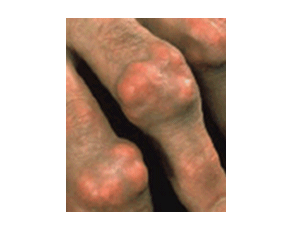Chronic tophaceous gout remains difficult to treat with available medications. Replacement of uricase, an enzyme essential for uric acid metabolism yet functionally deficient in humans, represents a promising therapy for uric acid lowering and resolution of tophi. Rasburicase, an available recombinant form of uricase, is limited in its use for gout due to immunogenicity. An alternate approach involves conjugation with polyethylene glycol (PEG), reducing immunogenicity potential. Prior studies have established the safety and efficacy of single doses of pegylated uricase for serum urate lowering. Here, Sundy et al (Arthritis Rheum 2008; 58(9); 2882) report the results of repeated doses of the pegylated uricase, peglitocase, on urate lowering and safety.
Methods
Adult men and women with gout and inadequate response or contraindication to urate lowering therapy (defined as serum urate > 6 mg/dL despite 3 months of therapy) were randomized to receive pegloticase in one of four groups: 4 mg every 2 weeks, 8 mg every 2 weeks, 8 mg every 4 weeks, and 12 mg every 4 weeks. The drug was administered as an IV infusion over 30 to 60 minutes. Current urate lowering therapies were washed out 1 week prior to randomization. Medications for prophylaxis against gout flares were prescribed at the discretion of the treating investigator.
The primary efficacy endpoint was reduction in plasma urate, defined as the proportion of patients per group with a urate level < 6 mg/dL for at least 80% of the study period lasting 14 weeks. Safety, pharmacokinetics, and pharmacodynamics were monitored throughout.
Results
A total of 41 patients were randomized, with 26 completing all doses. Most of the discontinuations (80%) were due to infusion reactions. At baseline, patient were primarily male (85%) with a mean age of 58 years. The mean duration of gout was 14 years with 71% of patients demonstrating tophi on examination. Reported gout attacks in the past 12 months were frequent (mean of 8 attacks). Most (61%) were included due to intolerance of urate lowering therapy. The average serum urate level was 10.3 mg/dL at baseline.
Plasma urate levels decreased to less than 6 mg/dL within 6 hours of the first infusion in all treatment groups and were sustained throughout treatment in all groups except for the lowest dosing group (4 mg every 2 weeks). The group receiving 8 mg every 2 weeks had the greatest average reduction in plasma urate at 86%.
Nephrolithiasis was common, with 15% of patients reporting at least one episode. Infusion reactions were observed in 18 patients (13%) and required withdrawal from the study for 12 of these. A small reduction in hemoglobin concentration was noted in most patients over the study interval. Most patients (88%) experienced at least one gout flare during the study. The frequency of flares was greater in the first month and decreased with time. Anti-pegloticase antibody developed in 31 patients (76%) and was associated with a reduction in efficacy. Preliminary analyses seemed to indicate that every 2 week administration of the agent reduced the effects of neutralizing antibody.
Conclusions
Multiple doses of pegloticase were effective at reducing uric acid levels in patients with treatment-refractory gout. Safety signal issues included infusion reactions, acute flares, nephrolithiasis, and immunogenicity.
Editorial Comment
Effective uricase replacement is a much anticipated therapy for gout. These data help to convince that there will be a role for pegloticase in clinical practice, particularly for gout patients with difficult to control disease and those for whom other urate lowering therapies are contraindicated. However, treatment may still be challenging, given issues related to flares, kidney stones, and immunogenicity. The last may be of particular concern, as compliance with urate lowering therapy in gout is known to be poor and, at least from these data, the effect of periodic non-compliance on immunogenicity has not been studied. Of particular interest with this agent is the potential to rapidly reduce the size of tophi. However, data on tophus reduction was not included in this report. The study presented here was relatively small and unblinded. Phase III data will undoubtedly clarify the safety signals noted here and confirm sustainability of response.


